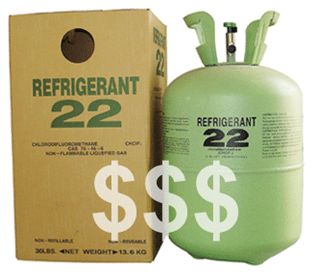We hope everyone made it through the storms last night safe and sound! If you…

That’s Crazy!! Yes, the Government Is Deliberately Making R-22 Expensive
You may remember the days when it was fairly cheap to recharge your air conditioner with a few pounds of Freon® (one brand name for R-22). It was a cheap fix that worked long enough to get a unit through a long, hot summer.
The days of low-cost recharge repairs are gone. If you have a heat & air system that is more than 5 years old, it uses R-22 refrigerant. R-22 contains CFCs (chlorofluorocarbons) which have been targeted for phase-out by the EPA. “Phase-out” means the EPA is limiting how much R-22 can be legally produced and imported in order to restrict supply. The more limited the supply of a needed item, the more it is going to cost.
And that is exactly what is happening. In 2010 we entered a new phase of restrictions and three years later, we are starting to see supplies get more expensive. The government is deliberately forcing homeowners to think very carefully about repairing old R-22 systems by making once-inexpensive repairs *much* more costly. They believe the best way to convince you to upgrade to the more environmentally friendly, and energy efficient newer systems is to make a simple repair super expensive.
Why is R-22 so high?
The government doesn’t want you to use it. The EPA mandated a phasedown program in the production of new R-22. From 2010 to 2014, their goal is for us to consume 75% less than the U.S. baseline. As more R-22 units are replaced, that baseline shifts lower, and less R-22 is produced.
We’ve seen prices increase 200-300% since 2010. The prices held steady for a while and the slight increases of the past few years flew under the radar, so this may be the first you are hearing about the issue. Price increases on R-22 are only going to go up and up – which is absolutely on purpose.
The Government Wants Your HVAC Professional to FIX Leaks
Part of the EPA’s strategy is to encourage homeowners to repair leaks. If you have a leak in your condenser coil and you don’t want to repair the leak (usually by changing out the coil) or upgrade to a new system, simply pumping more refrigerant into the unit is getting outrageously expensive. If you don’t repair the leak, refrigerant will continue to seep out into the environment, which is exactly what the EPA wants to discourage.
Are They Really Just Trying to Force Me to Buy a New System?
Well, yes. Upgrading your system has two distinctly different benefits:
1. R-410A: All new systems sold today use a more environmentally friendly refrigerant that doesn’t deplete the ozone. The most common refrigerant used in all new residential systems is called R-410A.
2. Higher Efficiency: New systems have greatly improved energy efficiency (use less energy) than units manufactured just five years ago. Even the lowest efficiency systems sold today use significantly less energy than the premium models produced few years ago. The newer systems use much higher pressure inside the components to maximize heat transfer. This will depend on your situation but we’ve seen some customers finance new units and find that their energy savings was more than their payment!
Can’t You Just Use R-410A to Fix My System?
The short answer is no. The two types of refrigerant do not work under the same conditions and should NEVER be mixed. To achieve the improvements in energy efficiency, the newer systems designed to work with R-410A have different configurations, pressures, thinner coils and types of metal. The refrigerants are just not interchangeable.
Can I Buy a New Condenser and Keep My Old Air Handler?
Unfortunately not. The two components must use the same refrigerant. When you make the decision to replace old R-22 equipment, you will need a whole new system.
You CAN replace just the coil with a new R-22 type coil…but we don’t usually recommend it if the system is 8 years or older. Coil replacement averages $2,000-$3,000, about half the cost of an entire new system. The average lifespan of a HVAC system is 8-12 years. Sinking significant money into an older system is not a wise investment when some other component on the system will fail in the near future.
Don’t Shoot the Messenger
We’ve heard loudly from angry customers that this issue is completely “made-up.” They are right, but WE aren’t the ones making this stuff up. We are a professional company, walking the fine line between giving customers the best repair or replace options given the reality of changing government mandates and the cost of materials.
Your heat and air system is going to break down eventually, even with proper maintenance. Your air conditioner runs all day, every day, keeping your home comfortable. It has many parts that eventually wear out after working constantly in all types of weather. We know it’s annoying and inconvenient when it breaks because you didn’t really plan to spend money on it right now. It’s not as fun or stylish as your car, but you probably spend way less money on your home’s heat and air system and expect more out it.
For more info, go straight to the source, visit the EPA’s website. We recommend you start here: http://www.epa.gov/ozone/title6/phaseout/22phaseout.html.
